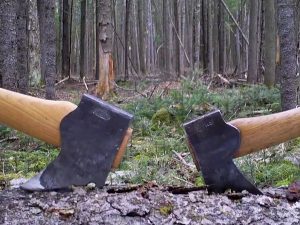Crosscutting saws have two fundamental uses: for felling and for crosscutting (bucking).
Blade shapes
There are three basic blade shapes: ribbon, flat back and salmon (or sway) backed. Although all three are interchangeable in use, their shape dictates their primary purpose.
Ribbon saws are felling saws. Their narrow width makes them easier to use with wedges, particularly for the felling of small trees.

Salmon backed saws are for crosscutting. The extra depth of blade gives greater rigidity and stability.
![]()
Flat backs are a hybrid. Cheaper to make, they will perform both operations well.

High quality saws may be taper ground; ie, thinner at the back than at the teeth. This minimises the amount of set required on the teeth.
Tooth configuration
There are innumerable tooth configurations. They can be very simplistically broken down into two groups. Those with rakers and those without.
The simplest (and earliest) saws were peg toothed. A row of identical teeth set alternately left and right.
![]()
From these evolved the crown pattern of tooth. Groups of three or four teeth separated by a gullet. Two-tooth groupings are known as M-teeth rather than
Crown teeth.
Varying setting patterns helped reduce ‘chatter’ and made for a smoother running saw.
![]()
As crown tooth patterns developed, so did raker toothed saws.
Here, groups of cutting teeth were separated by a raker, designed to pick up and carry the shavings out of the kerf.
![]()
– – – – – – – –
Gullet: a deep, round bottomed space between tooth groups (or rakers and teeth) to gather up and carry shavings out of the kerf.
Kerf: the slot left by the cutting action of the saw.
Set: the distance out of line of each tooth. Gives clearance for the saw blade
in the kerf.
Thanks to Brian Williamson of West Country Coppice

